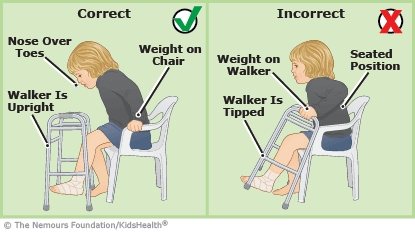Using a Walker Safely When You Have an Injury
For kids who have an injury that prevents them from walking, a walker can be a great way to get around and stay independent.


A walker gives an injured leg or foot a chance to rest so it can heal. It is important for a walker to fit well and be used correctly to prevent falls and more injury. Kids should be reminded that a walker is not a toy.
Depending on the injury, your child was told if the injured foot or leg should bear no weight, some weight, or full weight.
Your child was taught how to properly use the walker. From time to time, review these instructions with your child as a reminder of what was learned.
Safety tips:
-
Make sure the walker's pads and grips are securely in place and all hardware is tight.
-
Remove small, loose rugs from floors in the house.
Advice to give your child:
-
Wear snug, non-slip shoes and avoid flip-flops or other loose shoes that can cause falls.
-
Watch out for small pets around your feet.
-
Hold your weight up with your hands on the handgrips.
-
If wearing a backpack, keep it on both shoulders to help with balance.
-
Do not put weight on your injured leg unless your health care provider says it's OK.
-
Check your balance after each step.
-
Have someone around to help if you need it.
-
Take your time and go slowly.
-
Be especially careful on ramps, uneven ground, and wet surfaces.
-
Do not use the walker on stairs.
To sit in a chair:
-
Turn your back to the chair.
-
Walk backward until your legs touch the chair. Reach back with one arm and grasp armrest or seat.
-
Slowly lower yourself to the chair.
To get up from a chair:
-
Sit on the front edge of the chair.
-
Put both hands on the arms or the seat of the chair. Push against it to stand up.
-
Hold onto the walker with both hands.
-
Do not pull on the walker to stand up.
To walk with the walker:
-
Place the walker on the ground ahead of you just ahead of your toes.
-
If you are allowed to put weight on your injured leg, gently step forward with your injured leg. Then push down on the handgrips and step forward with your good leg.
-
If you are NOT allowed to put weight on your injured leg, push down on the handgrips and step forward with your good leg.
-
Repeat.
-
Take small steps and do not place the walker too far in front of you.
To go up and down a curb:
